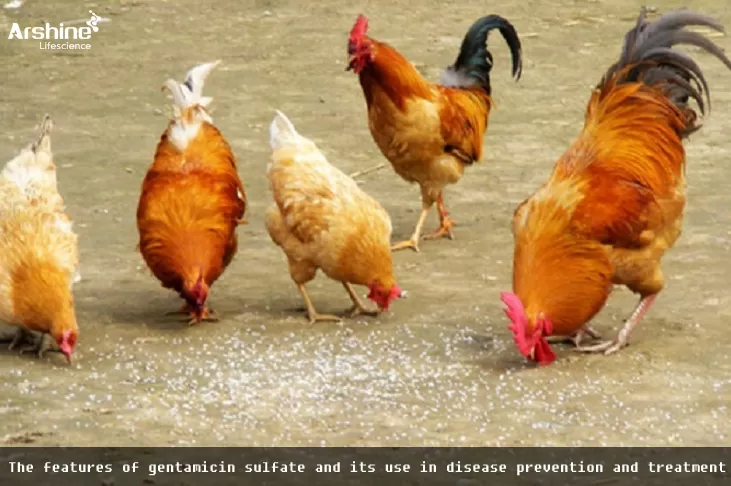

I. Characteristics of Gentamicin
Gentamicin sulfate is a broad-spectrum aminoglycoside antibiotic, belonging to the same class as neomycin sulfate, kanamycin sulfate, and amikacin. However, in clinical practice, gentamicin sulfate is more sensitive and safer than these drugs. It exhibits bacteriostatic and bactericidal effects against various Gram-negative and Gram-positive bacteria in veterinary medicine, including Escherichia coli, Salmonella, Mycoplasma, Pseudomonas aeruginosa, and Staphylococcus aureus.
It demonstrates a significant post-antibiotic effect (PAE) against both Gram-negative bacteria and Gram-positive cocci. This means that even after the drug is completely eliminated or its concentration falls below the minimum inhibitory concentration (MIC), it continues to suppress bacterial growth for a certain period.
Gentamicin is a concentration-dependent antimicrobial. Recent studies show that its antibacterial activity depends on the effective concentration of the antibiotic on the cell membrane. When the total daily dose remains unchanged, a single administration achieves a higher peak serum concentration (C~max~) than multiple daily doses, increasing the C~max~/MIC ratio and thereby enhancing antibacterial efficacy. This approach also reduces the risk of resistance and nephrotoxicity/ototoxicity, while minimizing stress reactions caused by repeated animal handling (e.g., oral dosing or injections).
When administered orally, gentamicin is poorly absorbed, resulting in high intestinal concentrations, making it suitable for treating intestinal infections such as piglet diarrhea (yellow and white scours) and enteritis.
After injection, gentamicin is rapidly and completely absorbed, reaching peak plasma concentrations within 0.5–1 hour (intramuscular route), with a bioavailability of ~90%. Increasing the dose elevates blood concentrations and moderately prolongs the duration of action.
As an alkaline compound, gentamicin is highly water-soluble and stable, with its strongest antibacterial activity in slightly alkaline environments.
Overdosing or prolonged use may lead to toxic side effects.
II. Drug Interactions
Synergism with β-lactam antibiotics (e.g., penicillins or cephalosporins): Combined use enhances efficacy against Gram-negative and Gram-positive bacteria. For example:
Gentamicin + penicillin → effective against Streptococcus.
Gentamicin + cephalosporin → effective against Klebsiella pneumoniae.
Mechanism: β-lactams damage bacterial cell walls, increasing gentamicin uptake by disrupting membrane permeability.
Synergism with trimethoprim-sulfa against E. coli and K. pneumoniae.
For severe systemic infections, combining gentamicin with dexamethasone or florfenicol improves cure rates.
Enhanced activity in alkaline environments:
Alkalinizing agents (e.g., sodium bicarbonate, aminophylline) potentiate antibacterial effects but increase toxicity.
Note: Efficacy declines if pH exceeds 8.4.
Incompatible with acidic drugs (e.g., vitamin C), which may reduce therapeutic effects.
III. Indications
Gentamicin is highly effective against severe infections caused by susceptible bacteria, including:
Resistant S. aureus, P. aeruginosa, E. coli, Proteus, Pasteurella, Salmonella, and other aerobic Gram-negative pathogens.
Conditions: Septicemia, urogenital infections, respiratory infections (pneumonia, bronchopneumonia), gastrointestinal infections (including peritonitis), mastitis, osteoarthritis, and skin/soft tissue infections.
IV. Dosage and Administration
To ensure optimal efficacy, consider gentamicin’s pharmacokinetics (absorption/distribution) and tailor dosing to the specific disease:
Injection:
Initial loading dose: ≥5 mg/kg, twice daily for 2–3 days.
Single daily dose: Double the amount (e.g., 10 mg/kg).
Oral: 10–15 mg/kg, divided into 2–3 doses/day for 2–3 days.
Severe dehydration: Dilute gentamicin in 20–40 mL of 5% glucose saline for intraperitoneal injection.
Critical cases: Adjust doses (oral/IM/IP) as needed.
V. Precautions
Do not mix gentamicin with penicillins/cephalosporins in the same syringe or IV bag—this reduces efficacy. Administer separately (e.g., IM gentamicin + IV penicillin).
Avoid oral gentamicin in newborn piglets before colostrum intake (risk of gastric ulcers).
Do not combine with other aminoglycosides (e.g., streptomycin, kanamycin, amikacin, neomycin)—increased toxicity.
Never administer IV push (may cause respiratory depression).
Add: Block 14, No.100, Luyun Road, Changsha 410205, Hunan, China.
Email: info@arshinevet.com
WeChat: +8618874001228
WhatsApp: +8615697311407
Tel:86-731-82294958